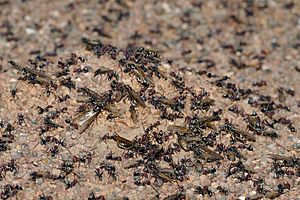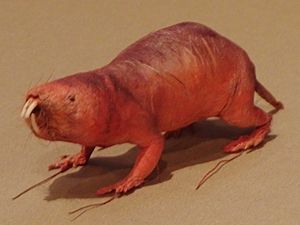Caste (biology) facts for kids
In some special animal groups, individuals of one species live together in large families called colonies. These groups are often known as nests or hives. In these colonies, different members often have different jobs. This is called a division of labour. For example, in insects like Hymenoptera (ants, bees, and wasps), a hive might have several types of females. Their bodies can even look different, and they do different tasks.
These specialized types within one species are called castes. Castes that do not have babies are usually sterile (meaning they cannot reproduce). The word "caste" first came from the caste system in Hinduism.
Eusociality is found in some insects, crustaceans (like shrimp), and mammals. It is most often seen and studied in the Hymenoptera (like ants, bees, and wasps) and in termites. In a eusocial colony, there are different castes:
- Queens and reproductive males are the only ones who have babies.
- Soldiers and workers team up to make a good home for the young ones.
Besides Hymenoptera and termites, two types of rodents are also eusocial: the naked mole-rat and the Damaraland mole-rat. Some shrimps, like Synalpheus regalis, are also eusocial.
Contents
What are Eusocial Animals?
Eusociality is a special way of life where animals live in highly organized groups. For a species to be called eusocial, it must have three main things:
- Cooperative care for the young: All members help raise the babies, even if they are not their own.
- Different generations living together: Parents, children, and even grandchildren live side-by-side at the same time.
- Division of labour: Different individuals have different jobs, especially when it comes to having babies. Some members are sterile (cannot reproduce) and focus on other tasks like finding food or defending the colony.
Examples of Eusocial Animals
Most eusocial societies are found in arthropods (insects and crustaceans), but a few are also found in mammals.
Eusocial Insects

The order Hymenoptera includes the largest group of eusocial insects. This group has ants, bees, and wasps. In these groups, there are reproductive "queens" and mostly sterile "workers" or "soldiers" who do special jobs. For example, in the social wasp Polistes versicolor, the main females build new cells and lay eggs. The other females do tasks like feeding the young and finding food. The females who are not the main reproducers do most of the foraging (81.4% of it!).
While only some bees and wasps are eusocial, almost all species of ants are. Some major groups within these families are mostly or entirely eusocial. These include certain bee tribes like Apini and Meliponini, and wasp groups like Polistinae.
Sometimes, eusocial behavior is controlled by special chemicals called pheromones. These pheromones change the behavior of specific castes in the colony. For example, worker bees of the Australian stingless bee Tetragonula carbonaria mark food sources with a pheromone. This helps their nest mates find the food easily.
Sterile members of the colony do specialized tasks to care for the members who reproduce. This can include individuals whose behavior or body is changed for group defense. Sometimes, they even sacrifice themselves for the group. This is called "altruism". An example is Myrmecocystus mexicanus, a type of honey ant. Some sterile workers fill their bellies with liquid food until they cannot move. They then hang from the ceilings of their underground nests. They act like living food storage for the rest of the colony.
Not all social insects have big differences in how their castes look. For example, in the social wasp Synoeca surinama, social actions decide the rank of individuals as they grow. These castes can also specialize their behavior based on age. For instance, Scaptotrigona postica workers take on different jobs in the nest depending on how old they are. When they are young (0–40 days old), they work inside the nest, cleaning and receiving nectar. After 40 days, they move outside to defend the colony and find food.
In Lasioglossum aeneiventre, a bee from Central America, nests can have more than one female in charge. These nests have more cells, and more females mean more efficient building and feeding of cells.
Termites are another large group of highly advanced eusocial animals. Their colony has different castes:
- The queen and king are the only ones who reproduce.
- Workers find food and keep the colony's resources.
- Soldiers protect the colony from attacks, especially from ants.
These workers and soldiers are sterile and do very specialized social behaviors. Some soldiers have such big jaws for defense that they cannot feed themselves and must be fed by workers.
Austroplatypus incompertus is a type of ambrosia beetle from Australia. It is the first beetle known to be eusocial. This species forms colonies where only one female reproduces. Many unfertilized females protect her and also work to dig tunnels in trees. They also help care for all the young ones, even if they are not their own.
Some gall-inducing insects, like the gall-forming aphid, Pemphigus spyrothecae, and thrips, are also eusocial. These species have very close relatives in their groups because they reproduce partly asexually (the sterile soldier castes are clones of the reproducing female). These species have soldier castes that can defend their colony against predators and other competitors.
Eusocial Crustaceans
Eusociality has also appeared three times in some crustaceans that live in separate colonies. Synalpheus regalis, Synalpheus filitigitus, and Synalpheus chacei are three types of shrimp that live in groups of close relatives in tropical reefs and sponges. They are eusocial, with one female who breeds and many male defenders. These males have large snapping claws for defense. Like other eusocial societies, they share one living space, and the non-breeding members protect it.
Sponges provide both food and shelter for these shrimp. This means many relatives gather in one place, and there is a lot of competition for these nesting spots. Being attacked often leads to a good defense system (soldier caste). Soldiers help the whole nest by keeping it safe and ensuring the queen can reproduce.
Eusociality gives shrimp populations an advantage. Eusocial shrimp species are more common, live in more places, and use more of the available resources than non-eusocial species.
Eusocial Mammals

Among mammals, eusociality is found in two species of mole-rats: the naked mole-rat (Heterocephalus glaber) and the Damaraland mole-rat (Fukomys damarensis). These mole-rats usually live in tough environments where resources are limited. They help raise their brothers and sisters and other relatives born to a single reproductive queen.
To avoid inbreeding (mating with close relatives), mole-rats sometimes leave their colony and start new ones if there is enough food. Most individuals work together to care for the young of one female (the queen), to whom they are usually related.
Some mammals in the Carnivora (like cats and dogs) and Primates (like monkeys and humans) show some eusocial-like behaviors. The most well-known are meerkats (Suricata suricatta) and dwarf mongooses (Helogale parvula). These animals help each other raise young, and there are clear differences in who gets to reproduce. In the dwarf mongoose, the breeding pair gets food first and is protected by other members. They rarely have to defend themselves from predators.
Images for kids
-
Co-operative brood rearing, seen here in honeybees, is a condition of eusociality.
-
Weaver ants, here collaborating to pull nest leaves together, can be considered eusocial, as they have a permanent division of labor.
See also
 In Spanish: Eusocialidad para niños
In Spanish: Eusocialidad para niños




